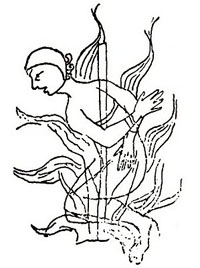
 This
is an extract from the text of a Church Council, called by and
presided over by Pope
Innocent III. It is regarded by Roman Catholics (but not the
Orthodox Church) as an Ecumenical or General Council, and therefore
enjoying a form of infallibilty to Catholics similar to the more
recently proclaimed "Papal Infallibility".
This
is an extract from the text of a Church Council, called by and
presided over by Pope
Innocent III. It is regarded by Roman Catholics (but not the
Orthodox Church) as an Ecumenical or General Council, and therefore
enjoying a form of infallibilty to Catholics similar to the more
recently proclaimed "Papal Infallibility".
The text is translated into English from the original Latin. Annotations to the right of the text are by the webmaster
| We excommunicate and anathematise every heresy
that raises against the holy, orthodox and Catholic faith
which we have above explained; condemning all heretics under
whatever names they may be known, for while they have different
faces they are nevertheless bound to each other by their tails,
since in all of them vanity is a common element. |
The Catholic Church in general (and Innocent III in particular) imagined all heresies to be essentially the same. The reference is to the little foxes, tied together by their tails by Samson and set alight, that damaged vinyards in Judges 15:4-5. |
| Those condemned, being handed over to the secular rulers or their bailiffs, let them be abandoned, to be punished with due justice, clerics being first degraded from their orders. | Punishment is mandated by the pope not, as sometimes claimed, secular rulers. |
| As to the property of the condemned, if they are laymen, let it be confiscated; if clerics, let it be applied to the churches from which they received revenues. |
This would became a cause for scandal, as the Church often abused its position, allegedly motivated by the lure of confiscated property. The Dominican Order, founded by Dominic Guzmán which ran the Inquisition, was a spectacular beneficiary. Dominican Inquisitors soon developed the idea of digging up and trying dead people, finding them guilty and dispossing their heirs. |
| But those who are only suspected, due consideration being given to the nature of the suspicion and the character of the person, unless they prove their innocence by a proper defence, let them be anathematised and avoided by all until they have made suitable satisfaction; but if they have been under excommunication for one year, then let them be condemned as heretics. |
Guilt, not innocence, was therefore assumed. The burden of proof was laid on the accused. An irony here is that except in the most exceptional circumstances (such as when the property interests of another Church Order were involved) Inquisitors would not permit anything approaching a "proper defence" |
| Secular authorities, whatever office they may hold, shall be admonished and induced and if necessary compelled by ecclesiastical censure, that as they wish to be esteemed and numbered among the faithful, so for the defence of the faith they ought publicly to take an oath that they will strive in good faith and to the best of their ability to exterminate in the territories subject to their jurisdiction all heretics pointed out by the Church; so that whenever anyone shall have assumed authority, whether spiritual or temporal, let him be bound to confirm this decree by oath. |
Temporal rulers are obliged by compulsory oaths to carry out the Church's orders. This provided a powerful weapon against rulers like Peter II King of Aragon Raymond VI Count of Toulouse, Raymond-Roger Trencavel Viscount of Béziers and Carcassonne, and Raymond Roger Count of Foix along with the Count of Comminge and the Viscount of Béarn: |
| But if a temporal ruler, after having been requested and admonished by the Church, should neglect to cleanse his territory of this heretical foulness, let him be excommunicated by the metropolitan and the other bishops of the province. | And if not they will be excommunicated - made into spiritual outcasts, refused admission to the mass, confession, baptism, matrimony, final unction, Christian burial, etc |
| If he refuses to make satisfaction within a year, let the matter be made known to the supreme pontiff, that he may declare the ruler's vassals absolved from their allegiance and may offer the territory to be ruled lay Catholics, who on the extermination of the heretics may possess it without hindrance and preserve it in the purity of faith; the right, however, of the chief ruler is to be respected as long as he offers no obstacle in this matter and permits freedom of action. The same law is to be observed in regard to those who have no chief rulers (that is, are independent). | In practice they will not only be stripped of their property, rights and privileges, but also accused of heresy themselves. This caused a scandal among European Kings as it purported to assign to the pope the right to reassign sovereign kingdoms - in other words to strip kings of their thrones. King John of England (brother-in-law of Raymond VI) was soon to be forced into obedience by the Pope's threat of exercising this new power. |
| Catholics who have girded themselves with the cross for the extermination of the heretics, shall enjoy the indulgences and privileges granted to those who go in defence of the Holy Land.... |
These indulgencies and prvlileges included a guaranteed place in heaven, irrespective of past or future sins. Incidentally, this sentence also confirms the intention to "exterminate" or "extirpate" the Cathars rather than reform them, as is occasionally now claimed by Church apologists. |
From The Disciplinary Decrees of the Ecumenical Council,
translated by H. J. Schroeder (St. Louis: B. Herder Book Co. 1937),
pp. 242-243 [copyright was not renewed on this edition]







